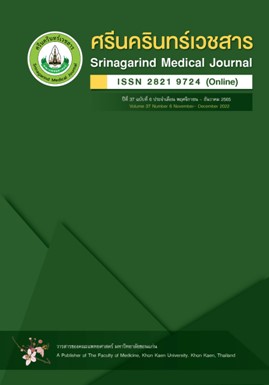ผลลัพธ์ของการตั้งครรภ์ในมารดาที่มีภาวะขาดสารอาหาร: การศึกษาจากเหตุไปหาผลแบบย้อนหลังสหสถาบัน
Abstract
วัตถุประสงค์: เพื่อศึกษาร้อยละของหญิงตั้งครรภ์ที่มีภาวะขาดสารอาหาร และเปรียบเทียบภาวะแทรกซ้อนระหว่างมารดาที่มีภาวะขาดสารอาหาร (ค่าดัชนีมวลกาย < 18.5 กก./ตร.ม.) กับมารดาปกติ และศึกษาหาจุดตัดที่เหมาะสมที่บ่งชี้ภาวะขาดสารอาหารที่มีผลต่อภาวะแทรกซ้อนขณะตั้งครรภ์ของหญิงไทย
วิธีการศึกษา: เป็นการศึกษาจากเหตุไปหาผลแบบย้อนหลังแบบสหสถาบัน เก็บข้อมูลผู้คลอดในโรงพยาบาลอุดรธานี อ่างทอง บ้านผือ บ้านดุง และเพ็ญ หาร้อยละของหญิงตั้งครรภ์ที่มีภาวะขาดสารอาหารและเปรียบเทียบอัตราการเกิดภาวะแทรกซ้อนในมารดาที่มีภาวะขาดสารอาหารเทียบกับกลุ่มปกติ โดยใช้การวิเคราะห์ถดถอยสัมพันธ์แบบพหุปัจจัย จากนั้นทำการวิเคราะห์แยกกลุ่มผู้ป่วยค่าดัชนีมวลกายที่ต่ำกว่า 21.5 กก./ตร.ม. ทีละหนึ่งกก./ตร.ม. นำมาเปรียบเทียบกับกลุ่มมารดาที่มีค่าดัชนีมวลกายตั้งแต่ 21.5-23 กก./ตร.ม. เพื่อหาจุดเริ่มต้นของดัชนีมวลกายที่ต่ำที่เริ่มมีผลกับภาวะแทรกซ้อนของมารดาและทารก
ผลการศึกษา: พบมีผู้คลอดในช่วงเวลาที่ทำการศึกษาจำนวน 24,068 ราย โดยมีผู้คลอดที่มีภาวะขาดสารอาหารจำนวน 4,056 รายคิดเป็นร้อยละ 16.85 (95% confidence interval (CI) 16.38 – 17.33) ในกลุ่มที่มีภาวะขาดสารอาหาร พบว่า ร้อยละ 45.17 เกิดภาวะแทรกซ้อน (adjusted Odds Ratio, AOR 1.34 , 95% CI 1.24-1.45) โดยพบว่าความเสี่ยงต่อภาวะเลือดจางก่อนคลอด ทารกเจริญเติบโตช้าในครรภ์ คลอดก่อนกำหนด และทารกแรกเกิดน้ำหนักน้อยมากขึ้น โดยมีค่า AOR และ 95%CI เท่ากับ 1.48 (1.33-1.64), 1.98 (1.78-2.21), 1.12 (1.01-1.26), และ 1.54 (1.39-1.71) ตามลำดับและพบว่าความเสี่ยงต่อภาวะแทรกซ้อนของมารดาและทารกจะเพิ่มขึ้นเมื่อค่าดัชนีมวลกายน้อยกว่า 19.5 กก./ตร.ม. (AOR 1.17, 95% CI 1.05-1.32)
สรุป: จากการศึกษานี้พบความชุกของภาวะขาดสารอาหารในมารดาร้อยละ 16.85 และแนะนำเกณฑ์วินิจฉัยภาวะขาดสารอาหารในมารดาไทยที่มีค่าดัชนีมวลกายต่ำกว่า 19.5 กก./ตร.ม. และมารดากลุ่มนี้มีความเสี่ยงต่อภาวะเลือดจางก่อนคลอด ทารกแรกเจริญเติบโตช้าในครรภ์ ทารกแรกคลอดน้ำหนักน้อยกว่า 2,500 กรัม และภาวะคลอดก่อนกำหนด จึงควรได้รับคำแนะนำด้านโภชนาการ เฝ้าระวังและรักษาภาวะแทรกซ้อนเหล่านี้
Pregnancy Outcome in Undernutrition Mothers: A Multicenter Retrospective Cohort Study
Pimjai Maleerat1, Metha Songthamwat2, Patinya Saeng-aroon3, Yaowaret Kittithanesuan2, Srisuda Songthamwat4, Ueamporn Summart5, Koollachart Saejueng6, Chatchanawadee Na Nan7
1 Ban Phue Hospital, UdonThani
2 Department of Obstetrics and Gynecology, AngThong Hospital, AngThong
3 Somdejpraboromrachineenart Natawee Hospital, Songkhla
4 Department of Obstetrics and Gynecology, UdonThani Hospital
5 Faculty of Nursing, Western University, Buriram
6 Ban Dung Hospital, UdonThani
7 Phen Hospital, UdonThani
Objective: To study the percentage of pregnancy with undernutrition (body mass index, BMI < 18.5 kg/m2), compare the complications between undernutrition and normal groups and define the optimum cut-point of undernutrition that affect the pregnancy complications in Thai women.
Materials and Methods: A multicenter retrospective cohort study in the pregnant women in UdonThani, AngThong, Ban Phue, Ban Dung and Phen Hospitals. The percentage of under BMI group was studied. The maternal and neonatal complications were compared between undernutrition and normal groups using multiple logistic regression analysis. Then each kg/m2 of BMI that less than 21.5 kg/m2 were compared with 21.5-23 kg/m2 group to define the low BMI that increased the pregnancy complications.
Results: From a total 24,068 deliveries, 4,056 cases (16.85 % (95% confidence interval (CI) 16.38 – 17.33)) of undernutrition pregnant women were found. In the undernutrition group, 45.17% had at least one pregnancy complication (adjusted odds ratio (AOR) 1.34 , 95% CI 1.24-1.45). The risk of anemia, small for gestational age, preterm birth and low birthweight under 2,500 g infant were increased significantly in the undernutrition group. The AOR and 95%CI were 1.48 (1.33-1.64), 1.98 (1.78-2.21), 1.12 (1.01-1.26), and 1.54 (1.39-1.71) respectively. The complication risk was increased in case of BMI < 19.5 kg/m2 ( AOR 1.17, 95% CI 1.05-1.32).
Conclusion: From this study’s data, the maternal undernutrition rate was 16.85%. The recommended cut-off BMI for undernutrition diagnosis was 19.5 kg/m2. This group has the risk for anemia, small for gestational age, low birthweight under 2,500 g and preterm birth, therefore the nutritional advice, surveillance and early treatment of complications were important in this maternal group.


